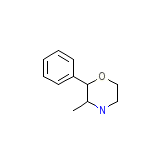Probese-P




Probese-P Brand names, Probese-P Analogs
- 2-Phenyl-3-Methylmorpholine
- 3-Methyl-2-phenylmorpholine
- Bromadryl
- Cafilon
- Dexphenmetrazine
- Fenmetrazin
- Fenmetrazina [INN-Spanish]
- Marsin
- Mefolin
- Neo-zine
- Oxazimedrine
- Phenmetraline hydrochloride
- Phenmetrazin
- Phenmetrazine hydrochloride
- Phenmetrazinum [INN-Latin]
- Preludin
- Preludin hydrochloride
- Probese-P
- Probese-P hydrochloride
- Psychamine A 66
- Psychamine A 66 hydrochloride
- USAF Ge-1
Probese-P Brand Names Mixture
- No information avaliable
Probese-P Chemical_Formula
C11H15NO
Probese-P RX_link
No information avaliable
Probese-P fda sheet
Probese-P msds (material safety sheet)
Probese-P Synthesis Reference
No information avaliable
Probese-P Molecular Weight
177.243 g/mol
Probese-P Melting Point
139 oC
Probese-P H2O Solubility
>5 mg/L
Probese-P State
Solid
Probese-P LogP
1.796
Probese-P Dosage Forms
Tablet
Probese-P Indication
Used as an anorectic in the treatment of obesity.
Probese-P Pharmacology
Phenmetrazine is a sympathomimetic drug used primarily as an appetite depressant. Its actions and mechanisms are similar to dextroamphetamine. Amphetamines are non-catecholamine sympathomimetic amines with CNS stimulant activity. Phenmetrazine was originally sold under the tradename Preludin as an anorectic. It has since been removed from the market. It is by some considered to have a greater potential for addiction than the amphetamines, and has been abused in many countries, for example Sweden.
Probese-P Absorption
Readily absorbed from the gastro-intestinal tract and buccal mucosa.
Probese-P side effects and Toxicity
Adult monkeys have an LD50 of 15 to 20 mg/kg, whereas for young monkeys the LD50 is only 5 mg/kg. Symptoms of overdose include acute central nervous system stimulation, cardiotoxicity causing tachycardia, arrhythmias, hypertension, and cardiovascular collapse. Whilst some patients show signs of toxicity at blood concentrations of 20 µg/L, chronic abusers of amphetamine have been known to have blood concentration of up to 3000 µg/L.
Probese-P Patient Information
No information avaliable
Probese-P Organisms Affected
Humans and other mammals














